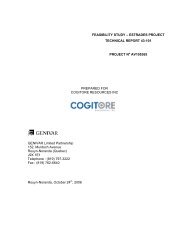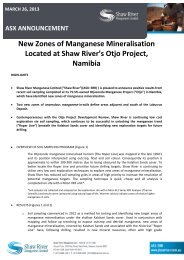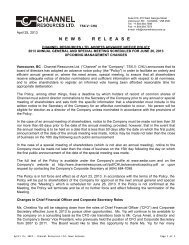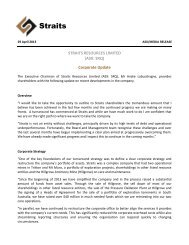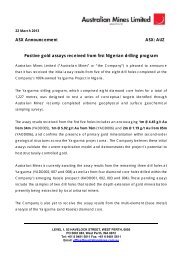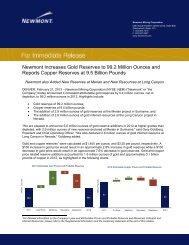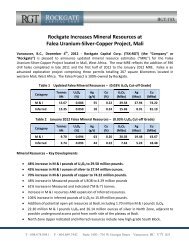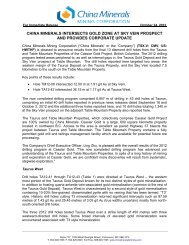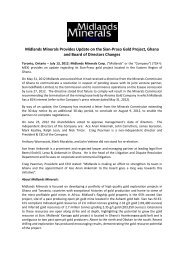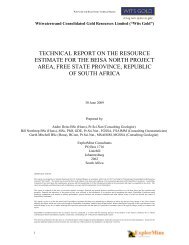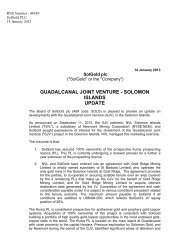Geotechnical Characterization and Sedimentation Behavior - InfoMine
Geotechnical Characterization and Sedimentation Behavior - InfoMine
Geotechnical Characterization and Sedimentation Behavior - InfoMine
You also want an ePaper? Increase the reach of your titles
YUMPU automatically turns print PDFs into web optimized ePapers that Google loves.
Shahid Azam, 1 Rick J. Chalaturnyk, 2 <strong>and</strong> J. Don Scott 3<br />
<strong>Geotechnical</strong> <strong>Characterization</strong> <strong>and</strong> <strong>Sedimentation</strong><br />
<strong>Behavior</strong> of Laterite Slurries<br />
<strong>Geotechnical</strong> Testing Journal, Vol. 28, No. 6<br />
Paper ID GTJ12511<br />
Available online at: www.astm.org<br />
ABSTRACT: Laterites are the main source of economic metals such as nickel <strong>and</strong> cobalt. In many parts of the globe, these metals are extracted<br />
using the pressure acid leach operation. An efficient rate of sedimentation <strong>and</strong> a high solids content of the material are two prerequisites for this<br />
process. To underst<strong>and</strong> the geotechnical behavior of laterite slurries under ambient process conditions, a comprehensive laboratory characterization<br />
<strong>and</strong> sedmentation protocol was developed. Results indicate that due to changes in material characteristics, sedimentation behavior of laterite slurries<br />
is improved during the metal extraction process. The rate <strong>and</strong> concentration of sedimentation are directly related for this class of materials.<br />
KEYWORDS: laterite, slurries, ore, PAL<br />
Introduction<br />
Laterites are the key source of economic metals such as nickel<br />
(Ni) <strong>and</strong> cobalt (Co). These residual soils contain 80 % of known Ni<br />
reserves on l<strong>and</strong> with sizeable amounts of Co (Golightly 1979). The<br />
pressure acid leach (PAL) process is the most widely used method<br />
for extracting metals from laterite ores due to its high recovery, low<br />
environmental risk, <strong>and</strong> economic viability (Motteram et al. 1996).<br />
This process uses selective metal dissolution in an acidic medium<br />
at elevated temperature <strong>and</strong> pressure (Chalkley <strong>and</strong> Toirac 1997).<br />
The method requires the conversion of the raw ores to slurries prior<br />
to the leaching operation that, in turn, generates slurries possessing<br />
a significantly different set of engineering characteristics. Given<br />
the increasing dem<strong>and</strong> for Ni <strong>and</strong> Co, there was an exigent need to<br />
conduct a comprehensive study of these materials.<br />
To obtain Ni <strong>and</strong> Co from the pregnant liquor in the slurry,<br />
the extraction process requires an expedient separation of the solid<br />
phase from the liquid phase. An efficient rate of sedimentation <strong>and</strong> a<br />
high solids content of the sedimented material are two prerequisites<br />
of the pressure acid leach operation. The subject matter of this<br />
research is a geotechnical assessment of various types of laterite<br />
ores used as input <strong>and</strong> of laterite PALs obtained as output in the<br />
hydrometallurgical operation for metal extraction.<br />
The main objective of this study was to develop a fundamental<br />
underst<strong>and</strong>ing of the sedimentation behavior of laterite slurries under<br />
ambient process conditions by highlighting the influence of ore<br />
geology <strong>and</strong> of the PAL process. For this purpose, a specialized<br />
laboratory characterization protocol was developed owing to the<br />
various peculiarities associated with this class of materials. Routine<br />
testing procedures were modified because of the following<br />
three reasons:<br />
Received January 11, 2004; accepted for publication April 11, 2005; published<br />
November 2005.<br />
1 Previously <strong>Geotechnical</strong> Engineer, Klohn Crippen Consultants Limited,<br />
500 Virtual Way, Vancouver, BC, Canada V5M 4X6.<br />
Research Associate, Department of Mining Engineering, University of<br />
British Columbia, Vancouver, BC, Canada, V6T 1Z4.<br />
2 Associate Professor, Department of Civil <strong>and</strong> Environmental Engineering,<br />
University of Alberta, Edmonton, AB, Canada T6G 2G7.<br />
3 Professor Emeritus, Department of Civil <strong>and</strong> Environmental Engineering,<br />
University of Alberta, Edmonton, AB, Canada T6G 2G7.<br />
1. Laterites have been reported to illustrate variations in engineering<br />
properties when dried by heating or by exposure to<br />
air (Townsend 1985);<br />
2. Dealing with heavy <strong>and</strong> fine-grained slurries with sometimes<br />
opaque pore fluids is entirely different from soils generally<br />
encountered by engineers during routine geotechnical investigation;<br />
3. The indispensable requirement to capture the expected<br />
changes in material characteristics during the metal extraction<br />
process.<br />
Based on laboratory investigations, this paper presents the engineering<br />
characteristics of laterite slurries at two stages of the metal<br />
extraction process: ore slurries <strong>and</strong> PAL slurries. At the outset, an<br />
overview of material characteristics such as mineralogy of the solid<br />
phase <strong>and</strong> chemistry of the pore fluid is presented. This is followed<br />
by providing geotechnical appraisal of laterites originating from<br />
different parts of the globe using index properties. Finally, all of<br />
these data are used to underst<strong>and</strong> the sedimentation behavior of<br />
both laterite ore <strong>and</strong> laterite PAL slurries.<br />
Materials<br />
The Metallurgical Technologies Division of Dynatec Corporation,<br />
Canada, provided laterite slurry samples. These included underflow<br />
ore slurries from the ore storage thickener <strong>and</strong> underflow<br />
PAL slurries from the first thickener of the multi-stage counter current<br />
decantation (CCD) wash circuit. Four laterite ore slurries were<br />
selected for geotechnical characterization from various parts of<br />
the globe: Cuba, Philippines, Australia, <strong>and</strong> Indonesia. The Cuban<br />
sample represented a limonite ore, whereas the Indonesian sample<br />
denoted a saprolite ore; the Philippines <strong>and</strong> the Australian samples<br />
corresponded to two distinct varieties of limonite <strong>and</strong> saprolite<br />
blended ores. For these ore slurries, the corresponding PAL slurries<br />
were obtained using consistent process conditions: temperature,<br />
245–250◦C; pressure, 4000–4100 kPa; reaction time, 50–60 min;<br />
<strong>and</strong> pH < 1.<br />
Table 1 where w, s, <strong>and</strong> EC are the water content, solids content,<br />
<strong>and</strong> electrical conductivity respectively, gives the characteristics of<br />
laterite slurries under ambient process conditions <strong>and</strong> indicates that<br />
Copyright © 2005 by ASTM International, 100 Barr Harbor Drive, PO Box C700, West Conshohocken, PA 19428-2959. 1
2 GEOTECHNICAL TESTING JOURNAL<br />
TABLE 1—Characteristics of laterite slurries under ambient process conditions.<br />
Sample Type <strong>and</strong> Origin<br />
Limonite Limonite-Saprolite Limonite-Saprolite Saprolite<br />
Process Stage Parameter Cuba Philippines Australia Indonesia<br />
Ore Slurries Color Pinkish Red Pink Dark Gray Red<br />
w, % 193.0 163.0 173.0 305.0<br />
s, % 34.0 38.0 37.0 25.0<br />
pH 7.1 7.2 7.5 7.3<br />
EC, µS/cm 156.0 744.0 1250.0 442.0<br />
Minerals ∗ G, H, M G, H, M, C C, G, H, M, A C, A, G<br />
PAL Slurries Color Brown Dark Brown Brown Light Brown<br />
w, % 177.0 119.0 131.0 261.0<br />
s, % 36.0 46.0 43.0 28.0<br />
pH 0.8 0.4 0.5 0.6<br />
EC, µS/cm >10000 † >10000 † >10000 † >10000 †<br />
Minerals ∗ H H H, S, A H, S,A<br />
∗ Mineral quantity decreases from left to right: A = Amorphous materials, C = Clay minerals, G = Goethite, H = Hematite, M = Maghemite, <strong>and</strong> S = Sulfates.<br />
† Upper limit of the measuring device.<br />
the pore fluid in the ore slurries was mainly neutral, whereas that<br />
in the PAL slurries was highly acidic. This high acidity required<br />
protective measures, such as preventing direct contact with the<br />
samples, neutralizing leaks with lime, <strong>and</strong> containment of spills.<br />
Laboratory Protocol<br />
General<br />
To characterize laterite slurries under ambient process conditions,<br />
a comprehensive laboratory investigation protocol was devised.<br />
This section gives a detailed account of the various test procedures<br />
modified after st<strong>and</strong>ards specified by ASTM International.<br />
Similarly, this section presents the sedimentation test specifically<br />
designed for these fine-grained slurries composed of heavy particles<br />
<strong>and</strong> opaque pore fluids. The methods of analyses of various<br />
test data are also given in this section.<br />
Laterites are prone to changes in properties caused by drying <strong>and</strong><br />
exposure to air (Townsend 1985). Air-drying at ambient temperature<br />
causes changes that cannot be reversed by rewetting (Fourie<br />
1997). Similarly, oven-drying at 105 ◦ C leads to partial or complete<br />
dehydration of the clay minerals present in soils, thereby resulting<br />
in significant variations in engineering properties (Frost 1976).<br />
Table 2 summarizes the laboratory protocol for characterizing laterite<br />
slurries. The possible occurrence of any permanent changes<br />
was precluded by avoiding air-drying. For all tests involving material<br />
drying, heating was conducted at an oven-temperature of 50 ◦ C.<br />
Other test specific alterations <strong>and</strong> their implications on results are<br />
described where appropriate.<br />
The metal extraction process requires that the ores be converted<br />
to fine-grained slurries <strong>and</strong> therefore the resulting PAL slurries are<br />
also fine-grained. Due to their heavy particles <strong>and</strong> the expected high<br />
settling rates of these slurries <strong>and</strong> because of the dark color of the<br />
pore fluid in the PAL slurries, the movement of the sedimenting<br />
material was digitally recorded. This greatly improved discerning<br />
the fast moving <strong>and</strong> sometimes vaguely visible solid-liquid interface<br />
of the slurry. The facility to electronically enlarge <strong>and</strong> refine<br />
the captured interface minimized observational error.<br />
Water Content<br />
At the reduced oven temperature of 50◦C, water content could<br />
be underestimated because of the incomplete removal of structural<br />
TABLE 2—Summary of laboratory protocol for characterizing laterite<br />
slurries.<br />
Material Property ASTM St<strong>and</strong>ard Modification<br />
Water Content, w D 2216-98 Drying at 50 ◦ C temperature<br />
No heating, vacuum used<br />
for air removal<br />
Specific Gravity, Gs D 854-00 Dry mass determined after<br />
test at 50 ◦ C temperature<br />
No drying<br />
Grain Size D 422-63 (1998) 25 g of soil (on dry mass<br />
Distribution basis) was used<br />
Dry mass obtained from<br />
subsample at 50 ◦ C<br />
temperature<br />
Consistency Limits D 4318-00 Drying at 50 ◦ C temperature<br />
pH D 4972-01 —<br />
Electrical D1125-95 (1999) —<br />
Conductivity, EC<br />
water (Holtz <strong>and</strong> Kovacs 1981). However, such discrepancies were<br />
considered negligible owing to the large amount of water present<br />
in the slurries. Using basic phase relationships, water content was<br />
translated to solids content according to the following equation:<br />
s = 1<br />
(1)<br />
1 + w<br />
Specific Gravity<br />
The specific gravity (Gs) was used to calculate void ratio (e). Assuming<br />
complete saturation <strong>and</strong> using unity for the specific gravity<br />
of water, void ratio was calculated from knowledge of solids content<br />
according to the following expression:<br />
� �<br />
1 − s<br />
e = Gs = Gsw (2)<br />
s<br />
Grain Size Distribution<br />
The hydrometer analysis was performed after dispersing the<br />
slurry by agitation with dilute alkaline sodium hexametaphosphate<br />
(Wintermeyer <strong>and</strong> Kinter 1954). Dispersion was ensured only for<br />
the ore slurries because of the expected presence of clay minerals,
which tend to flocculate <strong>and</strong> form flocs, thereby accelerating free<br />
fall under gravity (Lamb 1951). Due to the highly acidic pore fluid<br />
<strong>and</strong> the anticipated decay of clay minerals under harsh environments,<br />
no dispersing agent was used for laterite PAL slurries. This<br />
enabled the determination of the actual grain sizes before <strong>and</strong> after<br />
metal extraction. The hydrometer test was followed by sieve analysis<br />
on the same material washed with distilled water. The two data<br />
sets were combined to portray the entire grain size distribution. The<br />
s<strong>and</strong> size (>0.075 mm) defines the mechanical properties, whereas<br />
the clay size (
4 GEOTECHNICAL TESTING JOURNAL<br />
self-weight. The solid-liquid interface movement was captured at<br />
equal intervals of time using a camcorder with macro lenses that<br />
allowed image magnification of up to 7 times. The camcorder was<br />
connected to a computer that converted the captured frames to digital<br />
format. On the computer screen, the figure illustrates a magnified<br />
version of the focused area containing the solid-liquid interface.<br />
After the completion of the sedimentation test, the enlarged digital<br />
frame files were carefully viewed <strong>and</strong> the observed data were<br />
recorded as interface height versus time.<br />
The slope of the initial straight-line portion of the interface height<br />
versus time curve that represents hindered sedimentation, was used<br />
to determine the initial hydraulic conductivity (ki) according to the<br />
theoretical formulation given by Pane <strong>and</strong> Schiffman (1997). Using<br />
this settling velocity (Vs) of the interface <strong>and</strong> the unit weights of<br />
soil solids (γs)<strong>and</strong>water(γw), ki was determined according to the<br />
following equation:<br />
ki = γwVs(1 + e)<br />
(3)<br />
γs − γw The sedimentation test data was converted to void ratio-time <strong>and</strong><br />
solids content-time plots using Eq 2. Subsequent void ratios <strong>and</strong><br />
solid contents were calculated from the volume changes of the<br />
settling slurries.<br />
Results <strong>and</strong> Discussion<br />
Material Characteristics<br />
Table 1 summarizes the material characteristics of laterite ore <strong>and</strong><br />
PAL slurries. The color of various laterite ores ranges from pink<br />
to red <strong>and</strong> even dark gray. All these colors are invariably transformed<br />
to various shades of brown under the severe conditions of<br />
the PAL process. Derived either from the in situ geology or from<br />
the autoclave operation, the color of these samples denotes their<br />
composition that affects their distinct set of engineering characteristics.<br />
The water content of different laterite underflow slurries from<br />
the storage <strong>and</strong> CCD thickeners is also given. The table indicates<br />
that all ore slurries are associated with high water contents,<br />
which is attributed to the high water requirement for slurry preparation.<br />
The amount of water required to prepare suitable plant feed<br />
from laterite ores depends on particle bond strength, size of aggregates,<br />
<strong>and</strong> mineral composition (Schramm 1996). Removal of the<br />
strong sesquioxide coating on soil particles in these ores during wet<br />
screening is the key factor contributing to their high water dem<strong>and</strong><br />
(Golightly 1981). The table indicates lower values of water content<br />
for PAL slurries suggesting a lower water requirement for the PAL<br />
operation. According to Carlson <strong>and</strong> Simons (1960), the amount<br />
of water required in the autoclave mainly depends on availability<br />
that, in turn, is determined by the economics of the metal extraction<br />
process.<br />
The water content of the limonite-saprolite thickener underflow<br />
is lower than that of both the limonite <strong>and</strong> the saprolite. This is<br />
attributed to the possible presence of some mineral types in these<br />
samples containing adsorbed <strong>and</strong>/or structural water that cannot be<br />
removed at a temperature of 50◦C (Mackenzie 1957). Some of these<br />
materials include clay minerals formed in relatively arid climates,<br />
amorphous silica gels possessing water adsorbing properties, <strong>and</strong><br />
various forms of magnesium sulfates containing structural water.<br />
The corresponding solids content of laterite underflow slurries<br />
from the thickeners gives an insight into their dewatering behavior.<br />
Table 1 indicates a variable amount of released water for the<br />
investigated slurries, despite the fact that the initial solids content<br />
is generally of the order of 15 %. The limonite-saprolite slurries<br />
release more water than the other two slurries. This shows that the<br />
former slurries, obtained from blending limonite <strong>and</strong> saprolite materials,<br />
coalesce the positive characteristics of both ore types <strong>and</strong><br />
their subsequent PALs. Table 1 shows a general improvement in<br />
underflow solids content by 2–8 % during the metal extraction process.<br />
This indicates changes in both the solid <strong>and</strong> the liquid phases,<br />
as well as in the resulting colloid-electrolyte interactions in the ore<br />
<strong>and</strong> the PAL slurries.<br />
The pH values in the table show that the water used in slurry<br />
preparation is generally neutral to slightly basic. On the other h<strong>and</strong>,<br />
the extreme degree of acidity of the pore water is also highlighted<br />
by pH values less than 1 for all of the laterite PAL slurries. The<br />
EC measured for pore water of various ore slurries varies between<br />
150 <strong>and</strong> 1250 µS/cm, whereas that for the pore fluid of all PAL<br />
slurries reaches the maximum limit of the measuring device at<br />
10 000 µS/cm. This indicates that the pore fluids of the latter materials<br />
are rich in multivalent ions. Azam (2003) determined that<br />
H + ,Ca2+ ,Mg2+ ,Mn2+ ,Al3+ ,Fe3+ ,Ni3+ ,Co3+ <strong>and</strong> SO 2−<br />
4<br />
are the<br />
major ions in the pore fluids of the PAL slurries.<br />
Table 1 shows that the ores are mainly composed of goethite,<br />
hematite, <strong>and</strong> maghemite minerals. Clay minerals <strong>and</strong> amorphous<br />
materials such as silica <strong>and</strong> iron oxides are also present in sizeable<br />
amounts in ores derived from saprolite. Due to the high temperature<br />
<strong>and</strong> pressure <strong>and</strong> acid treatment in the autoclave, goethite<br />
<strong>and</strong> maghemite are converted to hematite, whereas the clay mineral<br />
species have completely decayed. Magnesium sulfates are formed<br />
by reaction between sulfuric acid <strong>and</strong> the released Mg 2+ from the<br />
ores. Because of difficulty in XRD identification, amorphous substances<br />
in the PALs may or may not be identical to the ores.<br />
<strong>Geotechnical</strong> Index Properties<br />
Table 3 provides a summary of the geotechnical index properties<br />
of the investigated laterite slurries. This table indicates that the<br />
specific gravity of laterite ores is higher than most sedimentary<br />
soils <strong>and</strong> falls within the range 2.9–3.2, common for residual soils.<br />
The Gs for laterite PALs is even higher <strong>and</strong> ranges between 3.2 <strong>and</strong><br />
3.6. Such high Gs values are attributed to the presence of heavy<br />
iron oxides in these materials (Gidigasu 1976) <strong>and</strong> contribute to a<br />
high solids content of the sedimented slurries, as observed earlier in<br />
Table 1. This is substantiated by the higher underflow solids content<br />
(Table 1) of the limonite-saprolite slurries because of their slightly<br />
higher values of Gs. Using these values of Gs <strong>and</strong> the observed<br />
underflow solids contents in Eq 2, the void ratio was calculated. The<br />
corresponding void ratios depicted in Table 3 reflect the underflow<br />
solids content in the ore storage thickeners <strong>and</strong> in the PAL CCD<br />
thickeners used in the metal extraction process.<br />
Figure 2 shows the grain size distribution of the various laterite<br />
slurries. The amount of s<strong>and</strong> size material is only up to 8 % for<br />
laterite ores <strong>and</strong> material finer than 0.075 mm is about 92 %. This<br />
is attributed to the fact that most laterite slurry preparation procedures<br />
use 0.85 mm as the maximum mesh size, thereby resulting<br />
in fine-grained materials. Removal of sesquioxide coating from<br />
such fine particles depends on inherent material properties such as<br />
bond strength, aggregate size, <strong>and</strong> mineral composition (Schramm<br />
1996). The 19–56 % clay size range for the ore slurries highlight<br />
the influence of geology <strong>and</strong> environment on laterites. The amount<br />
of s<strong>and</strong> size material is only 28–31 % for the corresponding laterite<br />
PALs. Material finer than 0.075 mm is in the range of 69–72 %<br />
<strong>and</strong> the clay size fraction varies from 6 to 19 %. Due to negligible<br />
dissolution of the fine material, both s<strong>and</strong> size increase <strong>and</strong> clay
TABLE 3—<strong>Geotechnical</strong> index properties of laterite slurries.<br />
Sample Type <strong>and</strong> Origin<br />
AZAM ET AL. ON LATERITE SLURRIES 5<br />
Limonite Limonite-Saprolite Limonite-Saprolite Saprolite<br />
Process Stage Parameter Cuba Philippines Australia Indonesia<br />
Ore Slurries Gs 2.92 3.16 2.92 2.92<br />
e 5.7 5.2 5.0 8.7<br />
−0.075 mm, % 93.0 93.0 92.0 92.0<br />
−0.002 mm, % 20.0 35.0 56.0 19.0<br />
C ∗ u — — — 17.3<br />
C † c — — — 1.0<br />
wl, % 60.0 83.0 95.0 108.0<br />
wp, % 44.0 42.0 48.0 53.0<br />
ws, % 35.0 25.0 29.0 29.0<br />
PAL Slurries Gs 3.22 3.56 3.22 3.22<br />
e 5.7 4.2 4.2 8.4<br />
−0.075 mm, % 70.0 71.0 69.0 72.0<br />
−0.002 mm, % 6.0 7.0 12.0 19.0<br />
C ∗ u 6.7 9.8 — —<br />
C † c 1.5 1.9 — —<br />
wl, % 26.0 27.0 50.0 83.0<br />
wp, % 17.0 16.0 30.0 42.0<br />
ws, % 15.0 14.0 18.0 25.0<br />
∗ Coefficient of Uniformity, Cu = D60/D10.<br />
† Coefficient of Curvature, Cc = (D30) 2 /(D10 × D60).<br />
size decrease are primarily attributed to grain size growth during<br />
the PAL operation (Tindall <strong>and</strong> Muir 1998).<br />
Figure 3 confirms the notion of grain size growth by comparing<br />
the morphology of laterite ore <strong>and</strong> PAL materials. Figure 3a is a<br />
SEM micrograph of a typical laterite ore <strong>and</strong> shows needle-shaped<br />
goethite crystals coating soil particles. Arranged in all directions<br />
similar to iron filings on a magnet, the size of individual goethite<br />
needles is of the order of 1 µm (Tindall <strong>and</strong> Muir 1998), which is<br />
half the clay size. Figure 3b, which is a SEM micrograph of the<br />
corresponding laterite PAL, illustrates globular hematite coating<br />
Finer Than (%)<br />
100<br />
80<br />
60<br />
40<br />
20<br />
0<br />
Clay Size (< 0.002 mm) Silt Size S<strong>and</strong> Size (> 0.075 mm)<br />
Ore PAL<br />
Limonite (Cuba)<br />
Limonite-Saprolite (Philippines)<br />
Limonite-Saprolite (Australia)<br />
Saprolite (Indonesia)<br />
0.0001 0.001 0.01 0.1 1<br />
Grain Size (mm)<br />
FIG. 2—Grain size distribution of laterite slurries.<br />
soil particles <strong>and</strong> occurring in separate but mutually conjoined<br />
colonies (Rubisov <strong>and</strong> Papangelakis 1999). Due to their inseparable<br />
fusion, the size of a singular hematite entity is difficult to ascertain.<br />
However, hematite globules with dimensions ranging between 1<br />
<strong>and</strong> 5 µm are clearly visible in this micrograph.<br />
Figure 2 further illustrates that the bulk of the materials in laterite<br />
slurries fall in the silt <strong>and</strong> clay size regions with variable<br />
clay size fractions. The variability in the grain size distribution<br />
curves among laterite ore <strong>and</strong> PAL slurries is due to the variable<br />
degree of coating of soil particles by sesquioxide <strong>and</strong> hematite,
6 GEOTECHNICAL TESTING JOURNAL<br />
FIG. 3—Change in morphology of laterite particles due to autoclave operation.<br />
respectively (Golightly 1981). Again, removal of such a coating during<br />
wet screening or the PAL operation depends upon particle bond<br />
strength, aggregate size, <strong>and</strong> mineral composition (Schramm 1996).<br />
The subtle variations among laterite slurries can be described by<br />
the terminology generally used for coarse-grained soils. Table 3<br />
gives an incomplete Cu <strong>and</strong> Cc data due to lack of D10 for some<br />
of the investigated materials. Therefore, the grain size distribution<br />
curves for such samples are visually examined (Holtz <strong>and</strong> Kovacs<br />
1981). Based on this qualitative observation, the limonite slurry<br />
from Cuba may be considered slightly gap-graded material (concave<br />
upward gradation curve with definable inflection points) that<br />
contains a clay size fraction of 20 %. On the contrary, the limonitesaprolite<br />
ore slurry from the Philippines is a well-graded material<br />
(relatively linear gradation curve <strong>and</strong> vague inflection points) with<br />
a clay content of 35 %. The limonite-saprolite ore from Australia<br />
is a poorly-graded slurry as more than half (56 %) of the material<br />
is finer than the clay size of 0.002 mm. The linear gradation curve<br />
<strong>and</strong> a Cu of 17.3 for the saprolite ore from Indonesia indicate a<br />
well-graded slurry containing 18 % clay size material.<br />
In contrast to the ore slurries, all of the laterite PAL slurries<br />
are fairly well-graded materials. However, the limonite PAL from<br />
Cuba <strong>and</strong> the limonite-saprolite PAL from the Philippines can be<br />
considered slightly less well-graded, as these samples contain a<br />
clay size fraction of about 7 %, Cu > 5, <strong>and</strong> Cc > 1. The limonitesaprolite<br />
PAL from Australia <strong>and</strong> the saprolite PAL from Indonesia<br />
are well-graded materials having higher clay contents of 12 <strong>and</strong><br />
19 %, respectively. The clay size fraction for the saprolite PAL<br />
slurry from Indonesia coincides with the ore slurry from which it<br />
is derived.<br />
The grain size distribution influences the mechanical <strong>and</strong> the<br />
physico-chemical interactions of laterite slurries. First, the very<br />
fine gradation of these slurries is partly responsible for the high<br />
void ratios in the thickeners, as indicated in Table 3. Second, wellgraded<br />
materials help minimize segregation of the clay <strong>and</strong> coarse<br />
fractions. Azam (2003) reported that at an initial solids content of<br />
15 %, most laterite slurries are essentially nonsegregating. Third,<br />
the clay size fraction of these slurries governs the colloid-electrolyte<br />
interactions, which in turn, influence consistency, sedimentation,<br />
<strong>and</strong> hydraulic conductivity.<br />
Table 3 indicates that laterites have variable consistency limits.<br />
This is attributed to their distinct mineralogy, which is derived from<br />
the ore geology <strong>and</strong> the PAL conditions as well as the chemistry<br />
of the pore water used during slurry preparation <strong>and</strong> autoclave operations.<br />
The high consistency limits of some of the laterite ores<br />
confirm the presence of clay mineral species <strong>and</strong> amorphous materials,<br />
such as iron oxide <strong>and</strong> silica (Mitchell 1993). Despite the<br />
high amount of clay size fraction, the low consistency limits of<br />
the limonite-saprolite ore from Australia indicate that the water<br />
used for feed preparation contained high concentrations of various<br />
electrolytes. These electrolytes were concentrated in the pore water<br />
during drying <strong>and</strong> fresh water was not added for the determination<br />
of liquid <strong>and</strong> plastic limits.<br />
The lower consistency limits of all of the laterite PALs than<br />
their ore counterparts substantiate that mineral transformation takes<br />
place during the PAL process. Since such transformation mainly<br />
occurs in sesquioxides whereas clay mineral structures tend to collapse,<br />
the limonite-saprolite PAL from Australia <strong>and</strong> the saprolite<br />
PAL from Indonesia retain somewhat higher consistency limits,<br />
possibly because of their amorphous materials possessing gelatinous<br />
<strong>and</strong> water adsorbing properties. Further, the reported high<br />
electrolyte concentration in the pore water is also partly responsible<br />
for the low consistency limits of the laterite PAL slurries.<br />
The plasticity chart (Casagr<strong>and</strong>e 1948) gives a preliminary assessment<br />
of the mineralogical composition of soils. Figure 4 is<br />
such a chart <strong>and</strong> shows the regions of common clay minerals <strong>and</strong><br />
the various investigated laterites. This figure illustrates that all of<br />
the laterite ores fall in the high liquid limit zone <strong>and</strong> below the<br />
A-Line. According to Holtz <strong>and</strong> Kovacs (1981), soils plotting in<br />
this region of the plasticity chart can be classified as micaceous<br />
fine s<strong>and</strong>y <strong>and</strong> silty clays. Based on their position on the plasticity
PlasticityIndex (%)<br />
Interface Height (cm)<br />
75<br />
60<br />
45<br />
30<br />
15<br />
9<br />
8<br />
7<br />
6<br />
5<br />
4<br />
3<br />
2<br />
1<br />
0<br />
Ore PAL<br />
Limonite (Cuba)<br />
Limonite-Saprolite (Philippines)<br />
Limonite-Saprolite (Australia)<br />
Saprolite (Indonesia)<br />
Kaolinite<br />
Smectite<br />
Hydrous Mica<br />
AZAM ET AL. ON LATERITE SLURRIES 7<br />
S<strong>and</strong><br />
High wl Low wl 0<br />
0 25 50 75 100 125<br />
Liquid Limit (%)<br />
0.1 1 10 100 1000<br />
Elapsed Time (min)<br />
U-Line<br />
FIG. 4—Plasticity chart for laterite slurries.<br />
Micaceous<br />
fine s<strong>and</strong>y <strong>and</strong> silty clays<br />
Laterite Ore Slurries Laterite PAL Slurries<br />
Limonite-Saprolite<br />
(Philippines)<br />
Limonite-Saprolite<br />
(Australia)<br />
Saprolite<br />
(Indonesia)<br />
Limonite<br />
(Cuba)<br />
chart, these laterite ores are expected to contain micaceous clay<br />
minerals such as chlorite <strong>and</strong> hydrous mica as well as kaolinite.<br />
Despite their low amounts in the samples (Table 1), these clay minerals<br />
greatly affect the consistency limits of the ground up ores.<br />
The corresponding laterite PALs are shifted downward <strong>and</strong> to the<br />
left on the plasticity chart. The limonite PAL from Cuba <strong>and</strong> the<br />
limonite-saprolite PAL from the Philippines are close to the region<br />
designated as s<strong>and</strong>. Similarly, the engineering behavior of the<br />
limonite-saprolite PAL from Australia is expected to be similar to<br />
A-Line<br />
Saprolite<br />
(Indonesia)<br />
Limonite-Saprolite<br />
(Australia)<br />
Limonite<br />
(Cuba)<br />
Limonite-Saprolite<br />
(Philippines)<br />
0.1 1 10 100 1000 10000<br />
Elapsed Time(min)<br />
FIG. 5—Interface height-time data during sedimentation of laterite slurries.<br />
that of the kaolinite, whereas the saprolite PAL from Indonesia is<br />
still classified as micaceous fine s<strong>and</strong>y <strong>and</strong> silty clay.<br />
<strong>Sedimentation</strong><br />
Figure 5 gives the sedimentation test data in the form of interface<br />
height versus time for laterite slurries. This figure shows that<br />
among the ore slurries, the limonite from Cuba has the most rapid<br />
sedimentation rate. This is attributed to the coarse texture of this
8 GEOTECHNICAL TESTING JOURNAL<br />
ground ore <strong>and</strong> the presence of a high amount of heavy iron oxides.<br />
At a neutral pH <strong>and</strong> a low EC of 156 µS/cm, physico-chemical<br />
interactions between the solids <strong>and</strong> the pore fluid are negligible.<br />
Therefore, the downward movement of the soil particles through<br />
water is predominantly mechanical in nature. This is followed by<br />
the limonite-saprolite ore slurry from the Philippines. The fairly<br />
rapid sedimentation rate of this slurry is due to the small amount of<br />
clay minerals in the 35 % clay size content <strong>and</strong> the higher amount<br />
of pore water electrolytes, which flocculate the fine material. The<br />
much slower sedimentation rate of the limonite-saprolite ore slurry<br />
from Australia is controlled by the presence of a large amount of<br />
clay minerals in the 56 % clay size fraction. The relatively high<br />
concentration of pore water electrolytes, as indicated by an EC of<br />
1250 µS/cm, appears to be insufficient for a thorough flocculation<br />
of this ore slurry. Although the amount of clay minerals is considerable<br />
in the saprolite ore slurry from Indonesia, this material<br />
also has a high amount of amorphous substances. In a near-neutral<br />
environment, the amorphous materials partially coat a significant<br />
amount of the clay platelets. This means that clayey material as<br />
well as individual clay platelets can be oppositely charged. Such<br />
incomplete coating of clays results in a voluminous cardhouse fabric<br />
that is difficult to dewater. Hence, the sedimentation rate of the<br />
saprolite ore slurry is very slow. The sedimentation rates of laterite<br />
ore slurries are affected by the coarseness of the grind, the clay size<br />
fraction, the presence of clay minerals <strong>and</strong> nonclay fine materials,<br />
<strong>and</strong> the chemistry of the pore water. Because of these variables, an<br />
accurate prediction of the sedimentation rate of laterite ore slurries<br />
is not straightforward. The investigated laterite ore slurries followed<br />
a decreasing trend from limonite through saprolite.<br />
The sedimentation rate order of the ore slurries is generally<br />
followed by the laterite PAL slurries. The limonite-saprolite PAL<br />
slurry from the Philippines, however, has the most rapid sedimentation<br />
rate partially due to the high specific gravity of 3.56 of its<br />
particles. Figure 5 shows that the sedimentation rate of the limonite<br />
Interface Height (cm)<br />
9<br />
8<br />
7<br />
6<br />
5<br />
4<br />
3<br />
2<br />
1<br />
0<br />
Laterite Ore Slurries Laterite PAL Slurries<br />
Ore PAL<br />
Limonite (Cuba) y = - 0.8029 x + 8.18 y = - 0.3250 x + 8.32<br />
Limonite-Saprolite (Philippines) y = - 0.1439 x + 8.35 y = - 0.4636 x + 8.36<br />
Limonite-Saprolite (Australia) y = - 0.0106 x + 8.33 y = - 0.0455 x + 8.46<br />
Saprolite (Indonesia) y = - 0.0010 x + 8.30 y = - 0.0132 x + 8.40<br />
0 5 10 15 20 25 30<br />
Elapsed Time(min)<br />
PAL slurry from Cuba is similar to that of the Philippines PAL slurry<br />
because of identical grain size characteristics, mineralogy, <strong>and</strong> pore<br />
water chemistry. The sedimentation rate of the other two slurries<br />
is much slower <strong>and</strong> may be attributed to the high water holding<br />
capacity of gelatinous amorphous materials <strong>and</strong> magnesium sulfate<br />
minerals. The observed variation between the limonite-saprolite<br />
PAL slurry from Australia <strong>and</strong> the saprolite PAL slurry from Indonesia<br />
is mainly attributed to the larger amount of amorphous<br />
material <strong>and</strong> magnesium sulfate in the latter material. The smaller<br />
dewatering amount of the saprolite PAL slurry from Indonesia is<br />
ascribed to the higher amount of structural water associated with<br />
the magnesium sulfate mineral present in this PAL material (Azam<br />
2003).<br />
Figure 6 shows the initial hindered sedimentation of the slurries.<br />
This initial part of the interface height-elapsed time plot is used for<br />
the determination of initial hydraulic conductivity. The slope of the<br />
initial straight-line portion of the sedimentation curve decreases<br />
from limonite through saprolite ore slurries. Among various laterite<br />
PAL slurries, the slope is highest for the limonite-saprolite<br />
PAL slurry from the Philippines. For other materials, the slope decreases<br />
from the limonite PAL slurry (Cuba) through the limonitesaprolite<br />
PAL slurry (Australia) <strong>and</strong> finally to the saprolite PAL<br />
slurry (Indonesia). It is interesting to note that the initial hydraulic<br />
conductivity obtained using the slope value is directly proportional<br />
to the total settlement of the corresponding slurry after sedimentation<br />
is completed (Table 4).<br />
Table 4 summarizes the sedimentation test results by reporting<br />
the initial conditions (initial height, Ho; initial solids content, so;<br />
<strong>and</strong> initial void ratio, eo), the final conditions (final height, Hf ;<br />
final solids content, sf ; <strong>and</strong> final void ratio, ef ), <strong>and</strong> ki during<br />
settling calculated from Eq 3 using the hindered settling velocity<br />
(Vs). This table indicates approximately constant initial conditions<br />
at the start of the sedimentation tests. The slightly higher values<br />
of void ratio for the limonite-saprolite slurries are due to the high<br />
5 10 15 20 25 30<br />
Elapsed Time(min)<br />
FIG. 6—Determination of initial hydraulic conductivity during sedimentation of laterite slurries.
TABLE 4—<strong>Sedimentation</strong> characteristics of laterite slurries.<br />
Sample Type <strong>and</strong> Origin<br />
AZAM ET AL. ON LATERITE SLURRIES 9<br />
Limonite Limonite-Saprolite Limonite-Saprolite Saprolite<br />
Process Stage Parameter Cuba Philippines Australia Indonesia<br />
Ore Slurries Ho, cm 8.30 8.36 8.34 8.30<br />
so, % 15.1 15.0 15.0 15.0<br />
eo 16.6 17.9 16.6 16.6<br />
Vs × 10 −4 , cm/s 8029.0 1439.0 106.0 10.0<br />
ki × 10 −4 , cm/s 1220.0 210.0 16.1 1.5<br />
Hf , cm 2.86 3.89 4.90 8.04<br />
sf , % 33.9 27.0 23.1 15.4<br />
ef 5.7 8.5 9.7 16.0<br />
PAL Slurries Ho, cm 8.35 8.50 8.50 8.50<br />
so, % 15.0 15.1 15.1 15.0<br />
eo 18.3 20.0 18.3 18.3<br />
Vs × 10 −4 , cm/s 3250.0 4636.0 455.0 132.0<br />
ki × 10 −4 , cm/s 470.0 639.0 65.7 19.1<br />
Hf , cm 2.70 1.95 4.30 6.25<br />
sf , % 35.3 43.5 25.9 19.4<br />
ef 5.9 4.6 9.2 13.4<br />
specific gravity of these materials. The table shows that the initial<br />
hydraulic conductivity of laterite ore slurries varies by three orders<br />
of magnitude from 1.2 × 10 −1 cm/s for the limonite ore slurry from<br />
Cuba to 1.5 × 10 −4 cm/s for the saprolite ore slurry from Indonesia.<br />
Conversely, the variation in the initial hydraulic conductivity from<br />
6.4 × 10 −2 to 1.9 × 10 −3 cm/s of the laterite PAL slurries is only<br />
1 1/2 order of magnitude.<br />
Figures 7 <strong>and</strong> 8 give the sedimentation test results in the form<br />
of void ratio <strong>and</strong> solids content as functions of time, respectively.<br />
These figures indicate that the void ratio <strong>and</strong> the solids content at<br />
the end of sedimentation of the different materials vary the same<br />
as the initial hydraulic conductivity; the higher the initial hydraulic<br />
conductivity, the greater the amount of settlement. This means that<br />
the rate <strong>and</strong> amount of sedimentation are directly related for the<br />
Void Ratio<br />
20<br />
15<br />
10<br />
5<br />
Laterite Ore Slurries Laterite PAL Slurries<br />
Limonite-Saprolite<br />
(Philippines)<br />
Limonite-Saprolite<br />
(Australia)<br />
Saprolite<br />
(Indonesia)<br />
Limonite<br />
(Cuba)<br />
0<br />
0.1 1 10 100 1000<br />
Elapsed Time (min)<br />
Saprolite<br />
(Indonesia)<br />
Limonite-Saprolite<br />
(Australia)<br />
Limonite<br />
(Cuba)<br />
Limonite-Saprolite<br />
(Philippines)<br />
0.1 1 10 100 1000 10000<br />
Elapsed Time(min)<br />
FIG. 7—Void ratio-time data during sedimentation of laterite slurries.<br />
investigated laterite slurries. Examining Table 4 in conjunction with<br />
Figs. 7 <strong>and</strong> 8 indicates that the sedimentation behavior is improved<br />
as a result of the pressure acid leach operation. Based on both<br />
efficiency (initial hydraulic conductivity) <strong>and</strong> yield (solids content<br />
after the completion of self-weight sedimentation), the limonitesaprolite<br />
from the Philippines is the most appropriate material for<br />
the metal extraction process. A threefold increase in the initial<br />
hydraulic conductivity <strong>and</strong> more than 60 % increase in the solids<br />
content are observed for this material during the PAL process.<br />
Summary <strong>and</strong> Conclusions<br />
Four ore slurries were selected from various parts of the globe:<br />
Cuba, Philippines, Australia, <strong>and</strong> Indonesia. The corresponding
10 GEOTECHNICAL TESTING JOURNAL<br />
Solids Content (%)<br />
10<br />
20<br />
30<br />
40<br />
50<br />
Laterite Ore Slurries Laterite PAL Slurries<br />
Limonite-Saprolite<br />
(Philippines)<br />
Limonite-Saprolite<br />
(Australia)<br />
Saprolite<br />
(Indonesia)<br />
Limonite<br />
(Cuba)<br />
0.1 1 10 100 1000<br />
Elapsed Time (min)<br />
PAL slurries were obtained using identical process conditions during<br />
metal extraction. Laboratory investigations to determine material<br />
characteristics, geotechnical index properties, <strong>and</strong> sedimentation<br />
behavior were performed. The main conclusions of this study<br />
are summarized as follows:<br />
� Laterite slurries constitute a distinct class of materials with<br />
geotechnical characteristics depending on the ore geology <strong>and</strong><br />
the metal extraction process. The ores are primarily composed<br />
of sesquioxides in a neutral environment, whereas the<br />
hematite-rich PALs occur at pH ≤ 1.0.<br />
� Laterite ores have a Gs of about 2.9 <strong>and</strong> require a high amount<br />
of water for conversion to slurries. The corresponding PALs<br />
have a Gs above 3.2 <strong>and</strong> exhibit a high water requirement<br />
during the autoclave operation for economic metal extraction.<br />
� More than 90 % of the material in ore slurries is finer than<br />
0.075 mm; the clay size fraction is between 20 <strong>and</strong> 60 %. During<br />
the PAL operation, grains undergo size growth <strong>and</strong> only<br />
about 70 % of the material is finer than 0.075 mm, <strong>and</strong> the clay<br />
size fraction is reduced to 5–20 %.<br />
� The combined effect of variable material characteristics influences<br />
sedimentation rate under self-weight. The initial hydraulic<br />
conductivity of the ore slurries ranges between 10 −1<br />
<strong>and</strong> 10 −4 cm/s <strong>and</strong> that of the PAL slurries between 10 −2 <strong>and</strong><br />
10 −3 cm/s.<br />
� The sedimentation behavior of laterite slurries generally improves<br />
during the PAL operation. The rate <strong>and</strong> amount of<br />
sedimentation are directly related for this class of materials.<br />
Acknowledgments<br />
The authors are grateful to the University of Alberta for providing<br />
laboratory space <strong>and</strong> computing facilities. Thanks are given to the<br />
Materials Technologies Division of Dynatec Corporation, Canada<br />
for material support.<br />
Saprolite<br />
(Indonesia)<br />
Limonite-Saprolite<br />
(Australia)<br />
Limonite<br />
(Cuba)<br />
Limonite-Saprolite<br />
(Philippines)<br />
0.1 1 10 100 1000 10000<br />
Elapsed Time(min)<br />
FIG. 8—Solids content-time data during sedimentation of laterite slurries.<br />
References<br />
Azam, S., 2003, Solid-Liquid Separation of Laterite Slurries, PhD<br />
Dissertation, University of Alberta, Edmonton, Alberta, Canada.<br />
Casagr<strong>and</strong>e, A., 1948, “Classification <strong>and</strong> Identification of Soils,”<br />
Transactions, ASCE, Vol. 113, pp. 901–930.<br />
Carlson, E. T. <strong>and</strong> Simons, C. S., 1960, “Acid Leaching, Moa Bays<br />
Nickel,” Journal of Metals, pp. 206–213.<br />
Chalkley, M. E. <strong>and</strong> Toirac, I. L., 1997, “The Acid Pressure Leach<br />
Process for Nickel <strong>and</strong> Cobalt Laterite, Part I: Review of Operations<br />
at Moa,” Proceeding, Nickel-Cobalt International Symposium,<br />
Sudbury, Ontario, Canada, Vol. 1, pp. 341–353.<br />
Fourie, A. B., 1997, “Classification <strong>and</strong> Index Tests,” Mechanics<br />
of Residual Soils, Blight, Ed., ISSMFE Technical Committee 25,<br />
Balkema, Rotterdam, The Netherl<strong>and</strong>s, pp. 57–63.<br />
Frost, R. J., 1976, “Importance of Correct Pretesting Preparation of<br />
Some Tropical Soils,” Proceedings, 1st South East Asian Conference<br />
on Soil Engineering, Bangkok, Thail<strong>and</strong>.<br />
Gidigasu, M. D., 1976, Laterite Soil Engineering-Pedogenesis <strong>and</strong><br />
Engineering Principles, Elsevier, Amsterdam, The Netherl<strong>and</strong>s.<br />
Golightly, J. P., 1981, “Nilckeliferous Laterite Deposits,” Economic<br />
Geology, Vol. 75, pp. 710–735.<br />
Golightly, J. P., 1979, “Nilckeliferous Laterites—A General Description,”<br />
Proceedings, International Laterite Symposium,New<br />
Orleans, Vol. 1, pp. 3–23.<br />
Holtz, W. G. <strong>and</strong> Kovacs, W. D., 1981, An Introduction to <strong>Geotechnical</strong><br />
Engineering, Prentice Hall, Englewood Cliffs, NJ.<br />
Lamb, T. W., 1951, Soil Testing for Engineers, John Wiley <strong>and</strong><br />
Sons, New York.<br />
Mackenzie, R. C., 1957, The Differential Thermal Investigation<br />
of Clays, Mineralogical Society, Clay Minerals Group,<br />
London.<br />
Mitchell, J. K., 1993, Fundamentals of Soil <strong>Behavior</strong>, 2nd ed., John<br />
Wiley <strong>and</strong> Sons, New York.<br />
Motteram, G., Ryan, M., Berezowsky, R., <strong>and</strong> Raudsepp, R., 1996,<br />
Murrin nickel cobalt.
AZAM ET AL. ON LATERITE SLURRIES 11<br />
Pane, V. <strong>and</strong> Schiffman, R. L., 1997, “The Permeability of Clay dustry, Schramm, Ed., American Chemical Society, pp. 3–<br />
Suspensions,” Geotechnique, Vol. 47, No. 2, pp. 273–288.<br />
44.<br />
Rubisov, D. H. <strong>and</strong> Papangelakis, V. G., 1999, “The Effect of Tindall, G. P. <strong>and</strong> Muir, D. M., 1998, “Effect Eh of on the Rate<br />
Acidity ‘at Temperature’ on the Morphology of Precipitates <strong>and</strong> <strong>and</strong> Mechanism of the Transformation of Goethite into Hematite<br />
Scale During Sulfuric Acid Pressure Leaching of Laterites,” 29th in a High Temperature Acid Leach Process,” Hydrometallurgy,<br />
Annual Hydrometallurgical Meeting, Montreal, Canada. Vol. 1, Vol. 47, No. 2–3, pp. 377–381.<br />
pp. 185–203.<br />
Townsend, F. C., 1985, “<strong>Geotechnical</strong> Characteristics of Residual<br />
Rouse, W. C., Reading, A. J., <strong>and</strong> Walsh, R. P. D., 1986, “VolcanicSoils,”<br />
ASCE, Journal of <strong>Geotechnical</strong> Engineering, Vol. 111,<br />
Soil Properties in Dominica,” West Indies, Engineering Geology, No. 1, pp. 77–94.<br />
Vol. 23, No. 1, pp. 1–28.<br />
Wintermeyer, A. M. <strong>and</strong> Kinter, E. B., 1954, “Dispersing Agents<br />
Schramm, L. L., 1996, “Suspensions: Basic Principles,” Sus- for the Particle Size Analysis of Soils,” Highway Research Board<br />
pensions: Fundamentals <strong>and</strong> Applications in Petroleum In- Bulletin, Vol. 95, No. 1, pp. 1–14.



